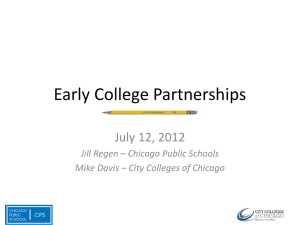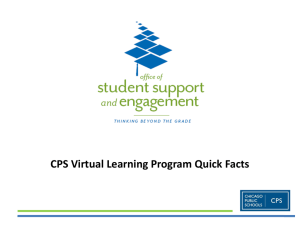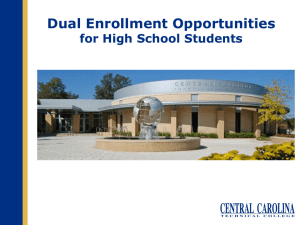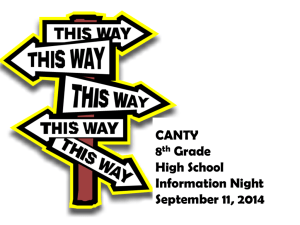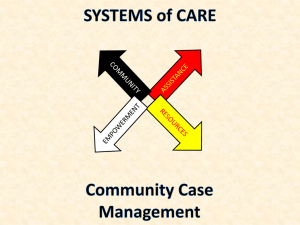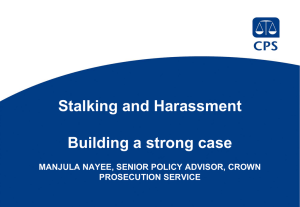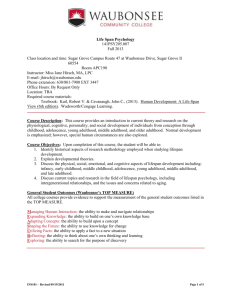Achieve. Grow. Build. - College Changes Everything
advertisement
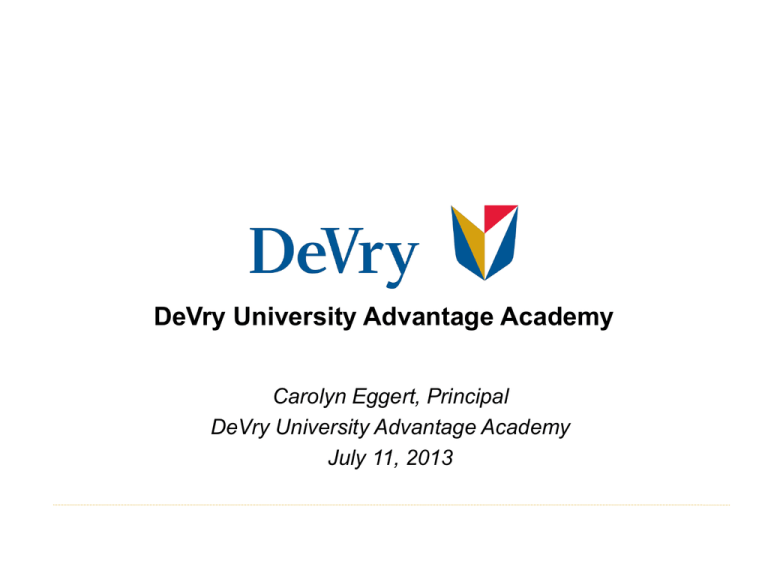
DeVry University Advantage Academy Carolyn Eggert, Principal DeVry University Advantage Academy July 11, 2013 DUAA Overview • DeVry partnership with Chicago Public Schools • Launched in 2004 • 8 classes graduated • 10th class to matriculate Fall 2013 • Dual degree: HS diploma + DeVry University associate degree • Network Systems Administration • Web Graphic Design • No tuition costs to students 2 DUAA Students • Students enroll at end of sophomore year HS • Enrollment eligibility • CPS students system-wide • 2.5 GPA • 90% attendance • Student demographics • 88% minority • 51% female 3 How it works • Administration • Partnership between autonomous organizations • CPS principal, counselors, clerk • DVU campus president, dean, academic & career services advisors • Educators • High school classes by CPS educators • College classes by DVU faculty • Facilities • 5 classrooms and 3 labs on DVU Chicago campus • Columbus, OH model: HS classes at native school, college classes at DVU campus 4 Organization chart DVU Campus President CPS Principal CPS Counselor 9 CPS Teachers: 2.0 English 2.0 Math 1.5 Science 1.0 Fine Arts 1.0 Social Studies 1.0 World Language 0.5 Special Ed Dean CPS Clerk DVU Faculty 5 Academic Advisor Career Services Advisor Typical student schedule Juniors Seniors 8:00 am Math 9:00 am English 10:00 am Science College courses: M, W, F Course 1 T, R Course 2 11:00 am Social Studies / World Language Noon Lunch Lunch 1:00 pm College courses: M, W, F Course 1 T, R Course 2 Fine Arts 2:00 pm 3:00 pm World Language / Science Math / English • Juniors take 4 high school classes in the morning. Every junior takes Math, English, and Science. The fourth class is typically Social Studies or World language. • Seniors take 3 high school classes in the afternoon. Courses vary widely based on what students need to earn their high school diploma / college and career interests. • All students take 2 college courses in an 8-week cycle. Courses are the traditional Monday / Wednesday / Friday and Tuesday / Thursday • Senior start time and junior end time vary by day according to the college schedule, and change every 8 weeks when courses change 6 Record of success • For first seven classes: • 94% high school graduation • 85% associate degree completion • 85% 4-year degree matriculation • Preliminary results for eighth class • 100% high school graduation • 93% associate degree completion • University of Chicago research findings: • Smaller environment, helpful faculty, excellent preparation for future schooling • Very likely to receive a postsecondary degree • Students: 90 percent would recommend 7 Lessons learned As program has evolved: • Creating extracurricular activities to meet students’ social needs • Rethinking academic schedules to align with student learning and individual students’ needs • Creating holistic experience for students/families through effective co-management by DVU and CPS • Understanding what is takes for students to be successful, and guiding students accordingly 8 Testimonial “Students in DUAA had their eyes opened by the program, many of whom would not have considered getting a college degree in the first place, let alone going on to pursue a bachelor’s degree. With this experience under their belts, their fear of college is gone.” - Jovanny C., 2006 DUAA graduate 9 Early College Partnerships July 11, 2012 Chadra Lang– Chicago Public Schools Freda Richmond– City Colleges of Chicago Many college bound high school students require remedial work • Majority of students from CPS are college bound. • Majority of CPS students coming to CCC require remediation. • Growing majority of jobs require post-secondary education. • Over the past ten years, early college existed at both CPS and CCC as separate entities. • Goal: To create a sustainable and predictable early college program that benefits high schools and CCC. 2005 – 2009 High School Cohort 29,388 CPS 9th Grade Enrollment Fall 2005 16,398 (56%) CPS Graduates 2009 - 2010 8,291 (54%) College Enrolled Fall 2009 2,833 (33%) CCC Enrolled 2,635 (93%) Students underprepared in at least one subject 198 (7%) Students college ready in English, Reading, Math Early College Milestones DEC 2012 JUNE 2012 JAN 2012 DEC 2011 NOV 2011 • Mayor and CCC Chancellor announces 100 free Dual Enrollment seats at each CCC campus (700 total each semester) • 20 schools • Mayor and CCC • Mayor and CCC Chancellor announces the launch of Dual Credit Math courses at CPS High Schools • CPS-CCC Working Group formed to develop Early College policies and procedures • Dual Credit Chancellor announce 5 Early College STEM Schools • 5 CPS High Schools pilot Dual Credit courses impacting over 200 students accepted as 201213 Dual Credit schools expansion announced for 2013-14 • 13 CTE Articulation Agreements available for CPS students • Dual Enrollment tripled enrollment from previous semester 13 Early College Overview HOW IT WORKS BENEFITS Dual Enrollment • High school students take CCC courses at a CCC location • Receive CCC Credit • Currently free for public HS students 1. High school students with college credit are more likely to persist and graduate. Dual Credit • CPS students take CCC courses at their HS • Receive both HS and CCC credit • Currently free for students 2. Early college students will not require remediation. CTE Articulation • HS students take a set of CPS courses which translate into specific CCC course credit • Requires enrollment at CCC Early College STEM Schools • CPS student can earn a high school diploma and associates degree within 6 years; incorporates Dual Credit, Dual Enrollment and articulated credit 3. CCC has a growing body of transfer agreements that could retain students. 4. Students can earn stackable credentials and college credits without exhausting financial aid. Early College Summary Dual Credit High Schools • Approximately 500 students enrolled in Dual Credit Math and/or English course 21 CPS Teachers accepted as CCC adjunct (SY2012-13) • 15 Schools (SY2012-13), • 90% (454) Completion, of which 77% (350) Earned Credit Dual Enrollment Programs • 894 Participating Students (Spring, Summer, & Fall 2012) • 469 Participating Students (Spring 2013) • 85% (398) Completion in Spring 2013, of which 87% (347) Earned Credit Early College Programs Early College STEM Schools • 900 Freshman Students (SY2012-13) • 5 High Schools (SY2012-13) • 5 Business Partners: IBM, Verizon, Motorola, Cisco, and Microsoft Career Technical Education Articulation Agreements • 13 CTE Articulated Agreements through Spring 2013 • 11 Agreements aligned to C2C • 53 CPS high schools have CTE programs 15 Wednesday, April Dual Credit| Fall 2013: 25 CPS High Schools offering courses Offers college eligible students college credit without transportation burden City College CPS High School 2010 - 2011 Spring 2012 16 Fall 2012 Tool-kit for developing Early College Collaborations • Identify key stakeholders from school district and post secondary partner • Regularly scheduled working team and leadership meetings • Develop an Advisory/ Governing Board • Develop a data sharing agreement • Identify metrics and evaluation process • Align academic calendar & marketing strategies Tool-kit for creating Concurrent Enrollment • Develop incentives for participation (high school, Principal, teacher and student) • Standard application process for participation • Identify high school and post secondary campus liaisons • Co-facilitate events & professional development sessions • Automate systems to share grades & test scores Early College| Early College helps students earn college credit while still enrolled in high school Characteristics of Early College Early diagnostic testing for college readiness Early identification of academic and career pathways Early College Early access to academic advising and support services Early access to academically rigorous courses 19 Early College Team and Contact Information Chicago Public Schools City Colleges of Chicago Name Email Name Email Josh Kaufmann jdkaufmann@cps.edu Freda Richmond frichmond1@ccc.edu Chadra Lang cllang@cps.edu Renee Daye Cross rdaye-cross@ccc.edu July 11, 2013 Tinley Park, Illinois Early College Credit Partnerships Shawn Munos, Assistant Principal for Teaching and Learning, West Aurora High School Dora Phillips, High School Partnerships Manager, Waubonsee Community College Waubonsee Community College Home of the Chiefs! • District encompasses 524 square miles in Kane, Kendall, DeKalb, LaSalle, and Will counties with four campuses. • Serves 22 municipalities with 12 public and 8 private high schools. • 2012-2013 enrollment of 31,158 students taking 197,852 credit hours. • District high schools vary in size from 85 students to 4,000 students. Waubonsee creates specific dual credit programs for each partner high school. Waubonsee Community College believes our success is defined by the dreams we help shape, the opportunities we help design, and the futures we help create. West Aurora High School West Aurora High School Home of the West Aurora Blackhawks! • • • • Second largest city in the state of Illinois City of four major school districts and numerous private schools 2012-2013 West Aurora High School enrollment of 3550 students 2012-2013 Student demographics - 3.5% Asian, 14.9% Black, 33.8% White and 44.7% Hispanic • 53.7% low-income students • 11.5% IEP students But statistics do not define who we are, the programs and opportunities that our students avail themselves of and have success in define the students who walk our halls. West Aurora High School Goals College Ready. All students will have the opportunity to graduate academically ready to attend college. College Successful. Develop a program of courses so varied that all students will have the opportunity to try their first college course and discover that they can achieve success. College Complete. Provide opportunities for each student to set and achieve a personal college completion goal. This includes completion of career certificates and associate degrees. West Aurora High School College Ready Nationwide, 60% of community college students take at least one developmental (below 100 level) class and only 25% of those students ever complete a program. Community College Research Center at Columbia University’s Teachers College Two semester developmental English course sequence offered as a Junior English option. Successful students may enroll in English 101/102 as Seniors. Three semester developmental math course sequence offered Junior/Senior year ends with a 4th semester transfer level math course for successful students. Courses are a blend of Common Core curriculum with Waubonsee’s Developmental Education curriculum. The daily high school schedule allows enough instructional time to fulfill both curriculums. West Aurora High School College Successful Students completing at least one college-level course before graduating from high school are more likely to attend and graduate from college. Taking College Courses in High School: A Strategy for College Readiness, Jobs for the Future, 2012 2013-14 Offer the following courses at West Aurora: COM100, ENG101, ENG102, MCM130, PSY100, MUS100, ACC120, ACC121, MTH101, MTH104, MTH111, MTH112, MTH131, MTH132, SPN201, SPN202, SPN205, SPN215, CAD100, CAD102, CMT101, BIO100, BIO101, BIO102, BIO103 Additional courses will be offered starting with the 2014-15 school year. Offer the following courses through a regional career center: FSC140, FSC150, FSC215, FSC115, FSC120, FSC125, FSC105, CRJ100, CRJ101, CRJ102, CRJ105, CRJ107, AUT100 Offer the following courses at *Waubonsee: EMT120, COM125, PBT105, PBT297, NAS101, HIT105 *Students may enroll any approved course for credit at Waubonsee. These courses are dedicated programs with tuition paid for by West. West Aurora High School College Complete Students in the class of 2017 are eligible to earn an Associate of Science degree with a STEM concentration and graduate from Waubonsee Community College 2 weeks prior to graduation from West. The courses are offered entirely at West Aurora High School and no tuition is charged to families. Currently, students can complete the following career certificates: Firefighter Certificate of Achievement (20 hours), Phlebotomy Technician (9 hours), EMT (9 hours), and CNA (7 hours) prior to high school graduation. Additional completion programs will be available as we move forward. By establishing a developmental education foundation combined with a full general education course sequence, West can now examine areas of concentration that are optimal for our students and community. Together we can build a smooth transition from high school to an educated and employable future for our students. West Aurora High School Forward Focus West Aurora High School is a 9-12 school offering a 9-14 education. We truly believe that “Every Blackhawk can be a Chief” during their high school years. West intentionally hires teachers with content area master’s degrees in order to increase the courses offered. Waubonsee waives tuition for all courses taught by qualified high school faculty. During the 2012-13 school year, 610 students enrolled in 1117 courses for 3,630 credit hours. This represents an actual tuition savings of $352,110 at the Waubonsee 2012 tuition rate of $97 per credit hour. For 2013-14, enrollment is on pace to double as increasing numbers of students find success in early college courses. West Aurora High School
